The Valentine – A Tribute to Love
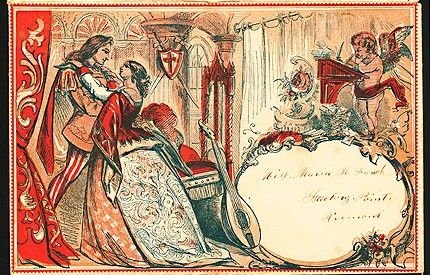
Nancy Rosin is President Emerita of the Ephemera Society of America and the President of the National Valentine Collectors Association. Now in its 40th year, the National Valentine Collectors Association preserves and communicates the history of this beautiful material, and enable collectors to meet people who share their passionate interest. While raising four children, Nancy’s valentine collection evolved, and now reflects the comprehensive history and evolution of the subject. Sharing her knowledge about the ephemera of love has been paramount, most recently at the American Museum of Folk Art in New York City and St. Bride’s Library in London.
The John Johnson Collection at the Bodleian Library has a valentines Pinterest project this year that focuses on rebuses and puzzles. Many of the items are from Nancy’s collection and can be viewed here.
Nancy often shares her wealth of knowledge, and she recently wrote a lovely article in Victoriana Magazine entitled, “The Valentine – A Tribute to Love.”
Nancy says: “As Valentine’s Day approaches, sentimental remembrances dominate the shelves, and dealers entice with chocolates, jewels, and lingerie. While modern cards bear little resemblance to the paper confections of long ago, the concept survives, bearing visions of romantic love and blissful marriage. Collectors of valentines and the related memorabilia, however, celebrate their holiday every day, researching and sharing their passion. Displays and articles have brought long-cherished love tokens to new audiences, where they are being appreciated with respect and fascination.”
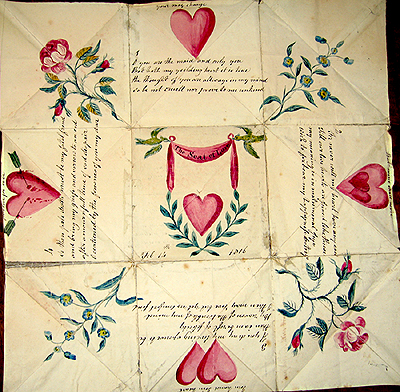
Puzzle Purse Valentine, dated 1816:
Found in England, but probably American. Watercolor on paper. A magical folding technique enables this to be folded into a secure packet — once opened, it is difficult to reassemble. The folds are numbered, and as opened, gradually reveal separate images and poems. The prize at the center is often a romantic image or poem, and perhaps — a special memento such as a ring or a lock of hair.
Nancy’s collection is awe-inspiring. She says, “Messages of love span the centuries, and are interwoven with culture and history to create a very poignant view of actual people and their sentimental values.”
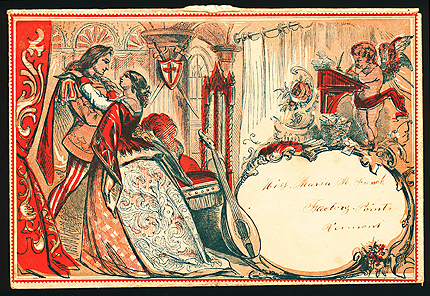
“Maria French” Envelope:
The lace treasure was preserved, carefully enclosed within the famous Romeo and Juliette envelope. Printed here in red, white and blue, it was also found in green and red. Factory Point, Vermont, now known as Manchester, happens to be the location of Hildene, the former summer home of Robert Todd Lincoln, eldest son of Abraham Lincoln and Mary Todd Lincoln. [5”x7”]
She gives insight into what it’s like to collect valentines: “Within this category, there is something of special interest for everyone, as Valentines are far from limiting. The preservation of sentimentality, love, artistry, elegance, and accompanying history make it an incomparable subject. Beyond the sugary open-outs, there is a wealth of beautiful material that is largely unknown. The subject permeated literature stimulated artists and passionately encouraged the creation of lasting treasures. They provide numerous areas for cross collecting, for the addition of these seemingly disparate items may actually enhance a collection. Impressive items appear on the market with surprising frequency, so even the rarest examples are not impossible to find.”
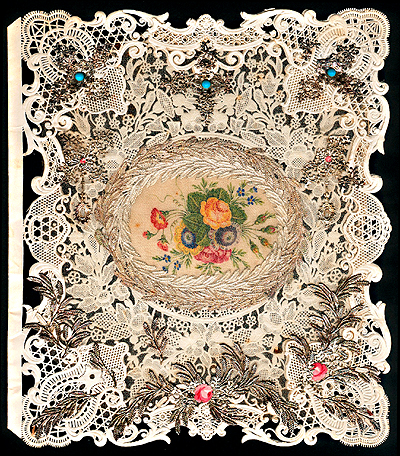
Elaborate lace quarto: Double-layered, openwork, cameo-embossed lace by the English firm of Joseph Meek, circa 1850, reflects the epitome of the workmanship of “The Golden Era.” The top layer is adorned with cabochon “faux jewels”, silk chiffon and silver Dresden die-cuts; a central window, bordered with a wreath of silvered leaves, reveals a subtle image of flowers — a message written in the Language of Flowers. When the top layer is lifted, the flowers are revealed as an exquisite watercolor painting. [8” x 10“]
The history of valentines is truly fascinating: ” Long associated with the exchange of Valentines is the delicious ingredient of mystery. Recipients were challenged to discover the identity of anonymous admirers, as mysteriously unsigned missives might be slipped under the door, tied to the doorknob, delivered by the postman, as well as transported by courier, coach, or rail. The tradition was an important aspect of nineteenth-century life, where romance and death were regularly feted in albums, poetry, and art. The holiday was so widely celebrated that by the 1830s, it is said that 60,000 valentines passed through the London post office.
By 1857, three million valentines were sold in New York City, the number reaching nearly a billion, by 2002.”
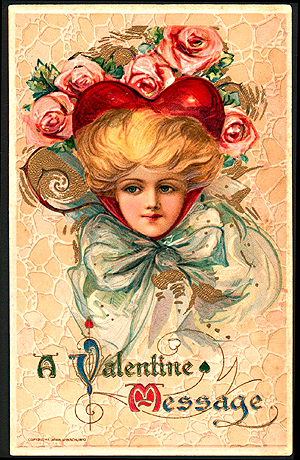
Winsch postcard – Design by Samuel L. Schmucker, and printed by the Winsch Publishing Company in 1910. Postcards became the natural evolution of the Valentine as the Industrial Revolution changed the styles in paper tokens of affection.
Please read Nancy’s article for more information about valentines and her beloved collection. She says, “These intensely personal and wonderful mementos demonstrate the relevance of expressions of love throughout history, how they have permeated art and life, and passionately celebrate the tradition of The Valentine.”
http://www.victoriana.com/VictorianValentine/valentinestributetolove.htm
